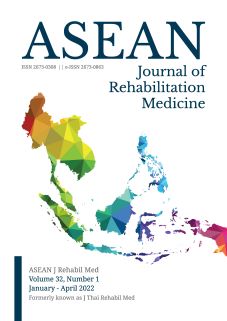The Effectiveness of Tongue Palatal Resistance Exercise for Increasing Suprahyoid Muscle Strength in Patients with Oropharyngeal Dysphagia: A Home Exercise Program During the COVID-19 Pandemic
Keywords:
oropharyngeal dysphagia, tongue, resistance exercise, COVID-19 pandemic, rehabilitationAbstract
Objectives: This study aimed to assess the effectiveness of a tongue palatal resistance exercise (TPRE) home exercise program for patients with oropharyngeal dysphagia.
Study design: One-group pre- and post-test.
Setting: Cipto Mangukusumo Hospital, Jakarta, Indonesia.
Subjects: Five patients with the following inclusion criteria: (i) oropharyngeal dysphagia, (ii) able to follow instructions, (iii) blood pressure < 160/110 mmHg, and (iv) never participated in a home oromotor exercise program.
Methods: The patients were trained to perform TPRE and were instructed to do 30 repetitions of the exercise per session, 3 to 5 sessions a week, for 2 weeks. Suprahyoid muscle strength was assessed using a surface electromyographic (EMG) biofeedback instrument before and then weekly after starting the home exercise program.
Results: The EMG activity of the suprahyoid muscle increased in all patients with a mean of 8.56 (SD 3.456) µV at baseline, 15.26 (SD 3.19) µV after the 1st week, and 17.44 (SD 3.922) µV after the 2nd week of TPRE.
Conclusions: A 2-week home program of tongue palatal resistance exercise can increase EMG activity, an indirect indication of increased suprahyoid muscle strength in individuals with oropharyngeal dysphagia. This home exercise program seems particularly appropriate during the current COVID-19 pandemic while hospital-based dysphagia rehabilitation services are limited.
Keywords: oropharyngeal dysphagia, tongue, resistance exercise, COVID-19 pandemic, rehabilitation
References
Saitoh E, Pongpipatpaiboon K, Inamoto Y, Kagaya H. Dysphagia evaluation and treatment. Singapore: Springer Nature; 2018.
Wahyuni LK. Disfagia: Tatalaksana Ilmu Kedokteran Fisik dan Rehabilitasi. Jakarta: CV Read Octopus; 2018.
Kim HD, Choi JB, Yoo SJ, Chang MY, Lee SW, Park JS. Tongue-to-palate resistance training improves tongue strength and oropharyngeal swallowing function in subacute stroke survivors with dysphagia. J Oral Rehabil. 2017;44:59–64.
O’Rourke F, Vickers K, Upton C, Chan D. Swallowing and oropharyngeal dysphagia. Clin Med (London). 2014;14:196–9.
Verin E, Clavé P, Bonsignore MR, Marie JP. Oropharyngeal dysphagia: when swallowing disorders meet respiratory diseases. Eur Respir J. 2017;49(4):1602530. doi. 10.1183/13993003.02530-2016.
Dysphagia Research Society. COVID-19 Information and resources: risk management of AGPs for Dysphagia Care [updated Oct 1, 2020] [Internet]. 2020. [cited 2021, Apr 17]. Available from: https://www.dysphagiaresearch.org/page/COVID19AGPs
Martin BJ, Logemann JA, Shaker R, Dodds WJ. Coordination between respiration and swallowing: respiratory phase relationships and temporal integration. J Appl Physiol. 1994;76:714–23.
Steele CM, Bailey GL, Molfenter SM, Yeates EM, Grace-Martin K. Pressure profile similarities between tongue resistance training tasks and liquid swallows. J Rehabil Res Dev. 2010;47:651–60.
Namiki C, Hara K, Tohara H, Kobayashi K, Chantaramanee A, Nakagawa K, et al. Tongue-pressure resistance training improves tongue and suprahyoid muscle functions simultaneously. Clin Interv Aging. 2019;14:601-8.
Steele CM, Bayley M, Peladeau-Pigeon M, Nagy A, Namasivayam A, Stokely S, et al. A randomized trial comparing two tongue-pressure resistance training protocols for post-stroke dysphagia. Dysphagia. 2016;176:139-48.
Watts CR. Measurement of hyolaryngeal muscle activation using surface electromyography for comparison of two rehabilitative dysphagia exercises. Arch Phys Med Rehabil. 2013;94:2542-8.
Nishimura K, Kagaya H, Shibata S, Onogi K, Inamoto Y, Ota K, et al. Accuracy of Dysphagia Severity Scale rating without using videoendoscopic evaluation of swallowing. Jpn J Compr Rehabil Sci 2015;6:124-8.
Bae Y, Park Y. The effect of relaxation exercises for the masticator muscles on temporomandibular joint dysfunction (TMD). J Phys Ther Sci. 2013;25:583–6.
Downloads
Published
How to Cite
Issue
Section
License
Copyright (c) 2021 ASEAN Journal of Rehabilitation Medicine

This work is licensed under a Creative Commons Attribution-NonCommercial-NoDerivatives 4.0 International License.






